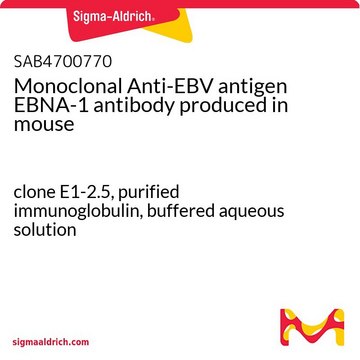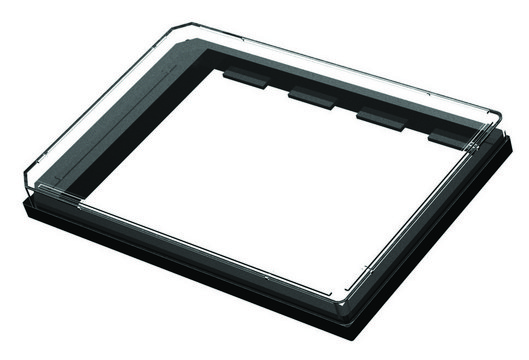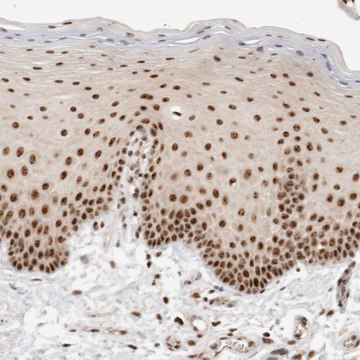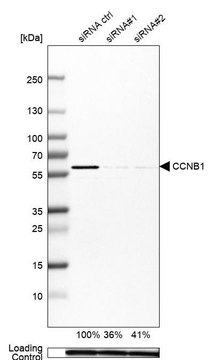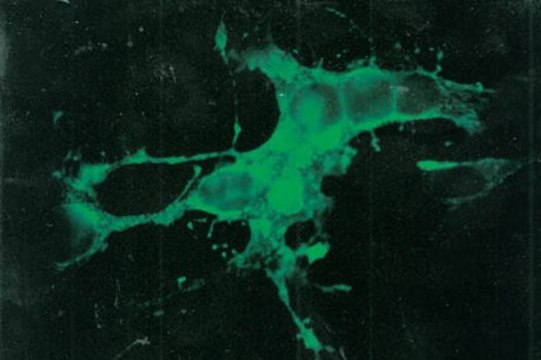MAB8184
Anti-EBV VCA gp125 Antibody, clone L2
clone L2, Chemicon®, from mouse
Synonym(s):
VCA-gp125
Sign Into View Organizational & Contract Pricing
All Photos(1)
About This Item
UNSPSC Code:
12352203
eCl@ss:
32160702
NACRES:
NA.41
Recommended Products
biological source
mouse
Quality Level
antibody form
purified immunoglobulin
antibody product type
primary antibodies
clone
L2, monoclonal
species reactivity
human
manufacturer/tradename
Chemicon®
technique(s)
ELISA: suitable
immunofluorescence: suitable
western blot: suitable
isotype
IgG1
shipped in
wet ice
Specificity
VCA-gp125
Application
Anti-EBV VCA gp125 Antibody, clone L2 is an antibody against EBV VCA gp125 for use in ELISA, IF & WB.
Immunofluorescence
ELISA
Immunoblotting (weak)
Optimal dilutions must be determined by the end user.
ELISA
Immunoblotting (weak)
Optimal dilutions must be determined by the end user.
Research Category
Infectious Diseases
Infectious Diseases
Research Sub Category
Infectious Diseases - Viral
Infectious Diseases - Viral
Physical form
Format: Purified
Purified immunoglobulin. In 0.02M phosphate buffer, 0.25M sodium chloride, pH= 7.6 with 0.1% sodium azide.
Storage and Stability
Maintain at 2-8°C.
Other Notes
Concentration: Please refer to the Certificate of Analysis for the lot-specific concentration.
Legal Information
CHEMICON is a registered trademark of Merck KGaA, Darmstadt, Germany
Disclaimer
Unless otherwise stated in our catalog or other company documentation accompanying the product(s), our products are intended for research use only and are not to be used for any other purpose, which includes but is not limited to, unauthorized commercial uses, in vitro diagnostic uses, ex vivo or in vivo therapeutic uses or any type of consumption or application to humans or animals.
Not finding the right product?
Try our Product Selector Tool.
Storage Class Code
10 - Combustible liquids
WGK
WGK 2
Flash Point(F)
Not applicable
Flash Point(C)
Not applicable
Certificates of Analysis (COA)
Search for Certificates of Analysis (COA) by entering the products Lot/Batch Number. Lot and Batch Numbers can be found on a product’s label following the words ‘Lot’ or ‘Batch’.
Already Own This Product?
Find documentation for the products that you have recently purchased in the Document Library.
Primary B-cell infection with a deltaBALF4 Epstein-Barr virus comes to a halt in the endosomal compartment yet still elicits a potent CD4-positive cytotoxic T-cell response.
Bernhard Neuhierl,Regina Feederle,Dinesh Adhikary,Birgit Hub,Karsten Geletneky et al.
Journal of virology null
Katerina Vrzalikova et al.
Blood, 117(22), 5907-5917 (2011-03-18)
An important pathogenic event in Epstein-Barr virus (EBV)-associated lymphomas is the suppression of virus replication, which would otherwise lead to cell death. Because virus replication in B cells is intimately linked to their differentiation toward plasma cells, we asked whether
Glycoprotein gp110 of Epstein-Barr virus determines viral tropism and efficiency of infection.
Neuhierl, B; Feederle, R; Hammerschmidt, W; Delecluse, HJ
Proceedings of the National Academy of Sciences of the USA null
Julien Batisse et al.
Journal of virology, 79(22), 14102-14111 (2005-10-29)
Most human herpesviruses, including Epstein-Barr virus (EBV), express a protein which functions primarily as an mRNA export factor. Previously, we deleted the gene for the Epstein-Barr virus mRNA export factor EB2 from the EBV genome and then introduced the mutated
Hongda Huang et al.
Nature communications, 7, 12707-12707 (2016-09-02)
The histone H3.3 chaperone DAXX is implicated in formation of heterochromatin and transcription silencing, especially for newly infecting DNA virus genomes entering the nucleus. Epstein-Barr virus (EBV) can efficiently establish stable latent infection as a chromatinized episome in the nucleus
Our team of scientists has experience in all areas of research including Life Science, Material Science, Chemical Synthesis, Chromatography, Analytical and many others.
Contact Technical Service